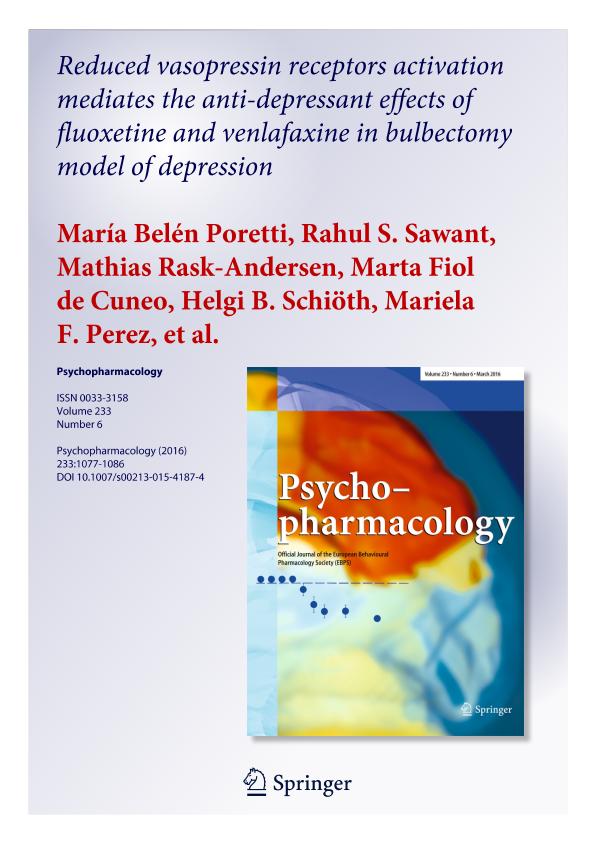Mostrar el registro sencillo del ítem
dc.contributor.author
Poretti, María Belén

dc.contributor.author
Sawant, Rahul S.
dc.contributor.author
Rask Andersen, Mathias
dc.contributor.author
Fiol, Marta Haydee

dc.contributor.author
Schioth, Helgi B.
dc.contributor.author
Perez, Mariela Fernanda

dc.contributor.author
Carlini, Valeria Paola

dc.date.available
2018-06-28T14:31:40Z
dc.date.issued
2016-03
dc.identifier.citation
Poretti, María Belén; Sawant, Rahul S.; Rask Andersen, Mathias; Fiol, Marta Haydee; Schioth, Helgi B.; et al.; Reduced vasopressin receptors activation mediates the anti-depressant effects of fluoxetine and venlafaxine in bulbectomy model of depression; Springer; Psychopharmacology; 233; 6; 3-2016; 1077-1086
dc.identifier.issn
0033-3158
dc.identifier.uri
http://hdl.handle.net/11336/50332
dc.description.abstract
Rationale: In response to stress, corticotropin releasing hormone (CRH) and vasopressin (AVP) are released from the hypothalamus, activate their receptors (CRHR1, CRHR2 or AVPr1b), and synergistically act to induce adrenocorticotropic hormone (ACTH) release from the anterior pituitary. Overstimulation of this system has been frequently associated with major depression states. Objective: The objective of the study is to assess the role of AVP and CRH receptors in fluoxetine and venlafaxine effects on the expression of depression-related behavior. Methods: In an animal model of depression (olfactory bulbectomy in mice, OB), we evaluated the effects of fluoxetine or venlafaxine (both 10 mg/kg/day) chronic administration on depression-related behavior in the tail suspension test. Plasma levels of AVP, CRH, and ACTH were determined as well as participation of their receptors in the expression of depression related-behavior and gene expression of AVP and CRH receptors (AVPr1b, CRHR1, and CRHR2) in the pituitary gland. Results: The expression of depressive-like behavior in OB animals was reversed by treatment with both antidepressants. Surprisingly, OB-saline mice exhibited increased AVP and ACTH plasma levels, with no alterations in CRH levels when compared to sham mice. Chronic fluoxetine or venlafaxine reversed these effects. In addition, a significant increase only in AVPr1b gene expression was found in OB-saline. Conclusion: The antidepressant therapy used seems to be more likely related to a reduced activation of AVP rather than CRH receptors, since a positive correlation between AVP levels and depressive-like behavior was observed in OB animals. Furthermore, a full restoration of depressive behavior was observed in OB-fluoxetine- or venlafaxine-treated mice only when AVP was centrally administered but not CRH.
dc.format
application/pdf
dc.language.iso
eng
dc.publisher
Springer

dc.rights
info:eu-repo/semantics/openAccess
dc.rights.uri
https://creativecommons.org/licenses/by-nc-sa/2.5/ar/
dc.subject
Avpr1b
dc.subject
Corticotropin Releasing Hormone
dc.subject
Crhr1
dc.subject
Depressive Behavior
dc.subject
Fluoxetine
dc.subject
Vasopressin
dc.subject
Venlafaxine
dc.subject.classification
Otras Ciencias Biológicas

dc.subject.classification
Ciencias Biológicas

dc.subject.classification
CIENCIAS NATURALES Y EXACTAS

dc.title
Reduced vasopressin receptors activation mediates the anti-depressant effects of fluoxetine and venlafaxine in bulbectomy model of depression
dc.type
info:eu-repo/semantics/article
dc.type
info:ar-repo/semantics/artículo
dc.type
info:eu-repo/semantics/publishedVersion
dc.date.updated
2018-06-26T17:18:43Z
dc.identifier.eissn
1432-2072
dc.journal.volume
233
dc.journal.number
6
dc.journal.pagination
1077-1086
dc.journal.pais
Alemania

dc.journal.ciudad
Berlin
dc.description.fil
Fil: Poretti, María Belén. Consejo Nacional de Investigaciones Científicas y Técnicas. Centro Científico Tecnológico Conicet - Córdoba. Instituto de Investigaciones en Ciencias de la Salud. Universidad Nacional de Córdoba. Instituto de Investigaciones en Ciencias de la Salud; Argentina
dc.description.fil
Fil: Sawant, Rahul S.. Uppsala University. Department of Neuroscience, Functional Pharmacology; Suecia
dc.description.fil
Fil: Rask Andersen, Mathias. Uppsala University. Department of Neuroscience, Functional Pharmacology; Suecia
dc.description.fil
Fil: Fiol, Marta Haydee. Consejo Nacional de Investigaciones Científicas y Técnicas. Centro Científico Tecnológico Conicet - Córdoba. Instituto de Investigaciones en Ciencias de la Salud. Universidad Nacional de Córdoba. Instituto de Investigaciones en Ciencias de la Salud; Argentina
dc.description.fil
Fil: Schioth, Helgi B.. Uppsala University. Department of Neuroscience, Functional Pharmacology; Suecia
dc.description.fil
Fil: Perez, Mariela Fernanda. Consejo Nacional de Investigaciones Científicas y Técnicas. Centro Científico Tecnológico Conicet - Córdoba. Instituto de Farmacología Experimental de Córdoba. Universidad Nacional de Córdoba. Facultad de Ciencias Químicas. Instituto de Farmacología Experimental de Córdoba; Argentina
dc.description.fil
Fil: Carlini, Valeria Paola. Consejo Nacional de Investigaciones Científicas y Técnicas. Centro Científico Tecnológico Conicet - Córdoba. Instituto de Investigaciones en Ciencias de la Salud. Universidad Nacional de Córdoba. Instituto de Investigaciones en Ciencias de la Salud; Argentina
dc.journal.title
Psychopharmacology

dc.relation.alternativeid
info:eu-repo/semantics/altIdentifier/url/https://link.springer.com/article/10.1007%2Fs00213-015-4187-4
dc.relation.alternativeid
info:eu-repo/semantics/altIdentifier/doi/http://dx.doi.org/10.1007/s00213-015-4187-4
Archivos asociados
